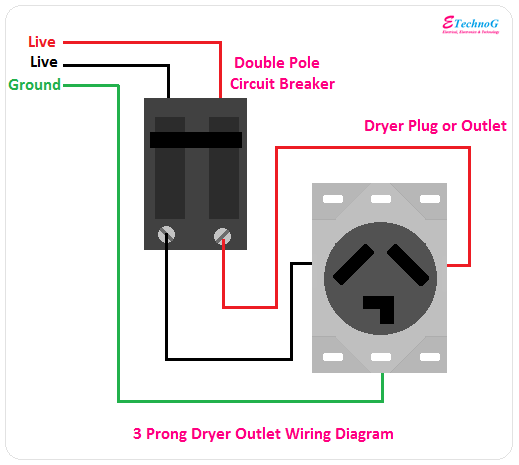Diagram for Wiring a Dryer Plug or Dryer Outlet
Hey, in this article we are going to know the procedure for wiring a dryer outlet or dryer plug. Also, we will see the dryer outlet wiring diagram for different types according to the number of prongs. Here, you will learn about both 3-prong dryer outlets and 4-prong dryer outlets. Here, also we will see the connection of the circuit breaker with the outlet. First, let's see the terminal diagram of each outlet.
3 Prong Dryer Outlet Terminal Diagram
Here, you can see the terminals of a 3-prong dryer outlet. A 3-prong dryer outlet is also known as a NEMA 10-30 outlet that consists of three slots. You can see in the above diagram that it has two flat vertical slots (hot wires) positioned diagonally and one L-shaped slot (neutral wire) located below the two hot slots. It has a total of 3 prongs to plug the dryer. The lower middle is for the grounding connection. So, it is to be connected to the ground or earth. Another two prongs are for Lines or terminals. These two terminals are to be connected to a double-pole circuit breaker. Each of these terminals are carrying 120V. So the total of the outlet is 240V. One 120V plug is used to supply the power to the heater and motor and another is for simple lighting, indicating, etc.
4 Prong Dryer Outlet Terminal Diagram
Here, you can see the terminals of a 4-prong dryer plug dryer outlet. A 4-prong dryer outlet is also known as a NEMA 14-30 outlet that has four slots. It includes two hot slots similar to the 3-prong outlet but it also has an additional L-shaped slot (neutral wire) and a separate grounding slot. The fourth slot, known as the grounding slot, is a rounded or U-shaped hole positioned below the other slots. It has a total of four terminals. The lower middle terminal is for neutral. And the upper middle terminal is for grounding or earthing. The lower-middle terminal is to be connected to the neutral of the power supply directly and the upper-middle terminal is to be connected to the earth. Also, note that here, neutral and ground must be separated and use different color codes. Both side horizontal prongs are for line or hot terminals. Each of these also carries 120V. So the total output is 240V.
Read Also:
Wiring diagram of Dryer Outlet - 3 Prong
Here, you can see the lower middle terminal is connected to the ground with a green wire. And both hot terminal is connected to the double-pole circuit breaker. A circuit breaker must be used with the dryer outlet as it provides protection against short circuit fault and overload fault. Mostly, a 2 pole 30Amp breaker is used with a dryer outlet.
If we see the connection procedure,
- Connect the lower middle terminal to the earth or ground
- Connect both of the hot terminals to the circuit breaker as shown in the above diagram.
- Here, for a better understanding purpose, we have shown the input terminals of the breaker. In general, the breaker is placed in a power panel.
Dryer Outlet Wiring Diagram - 4 Prong
Here, you can see the lower middle terminal is connected to the neutral with a white wire. Both yellow and white can be used for the neutral. The upper-middle terminal is connected to the ground or earth with a green wire. Both of the hot terminals are connected to the double pole circuit breaker.
If we see the connection procedure,
- Connect the lower middle terminal to the neutral with a white or yellow wire.
- Connect the upper-middle terminal to the ground or earth with a green wire.
- Connect the live terminals to the circuit breaker as shown in the above figure.
Read Also:




